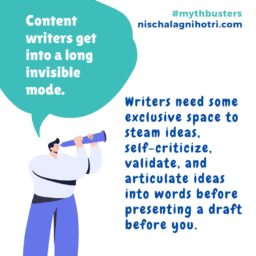It is annoying not to hear from your writer, for days. Suddenly, an email pops into your inbox from the writer. You are excited that finally, you have an article that could get published, and when you open the document, you are like eeewww!!
Thankfully, professional writers avoid delivering this kind of first-level experience.
What should you expect out of a first draft?
Test Waters.
Even before setting expectations from a content writer, try and agree upon what you want from the writer, and find out what is a writer capable of delivering. How can you do this?
Test waters:
- Ask for the writer’s portfolio
- Talk to her existing clients
- Request for a trial article that you promise to pay for
- Take a look at their official blog
- Ask them for feedback about your existing blog
Once you are convinced, set the right expectations and wait for the first output. If you need detailed insight into how to manage your content writer, download the free e-book titled, “Make most out of your Content Writer”

First Draft.
The output depends upon what you have hired the writer for.
Did you hire them for a video script, a blog article, a whitepaper, social media posts, and so on?
Redoing an entire article or any content asset without an approved structure is a futile exercise leading to poor productivity.
Poor Productivity = High Costs
The first draft should include:
- Structure: The originally agreed structure of the content asset. For eg: if it is a blog post, then the opening para, image placeholder recommendations, necessary quotes, how-to guides, and closing remarks. If it is a case study, then it the problem, solution, implementation process, and the impact on the customer. Define the structure before you get to work. The structure of any content asset includes ideation syntax and thought flow, persuasion techniques, a hierarchy of statements to craft an argument, and so on.
- Call-to-actions: In large organizations, the editor provides guidelines for CTA placeholders. But, if you are working with a freelance writer, then you need to discuss the preferred CTAs to be included in that asset. The content asset could be a webpage, email draft, video script, blog post with inline CTAs, a podcast script, or anything else that you can imagine.
- Hyperlinks: Most often missed out. You need to take advantage of internal linking with SEO-friendly anchor text. Keep this handy before the writer gets down to production. A list of necessary keywords and anchor text is useful to churn out great output.
- Objective: I am mentioning this as the last piece because it the most important. Sticking to the objective helps in crafting a high-quality content asset. The frills will fall in place. I have a detailed section catered to share a few objectives that different content assets could fulfill.
Content Assets and their Objectives
There could be more than one purpose that a given content asset could fulfill. But, here is the thing. You need to determine a ‘primary purpose’ and hand it over to your writer. That should drive the creation of any content asset.

To receive a customized content purpose document and drive targeted conversions, reach out to me @nischalagni on Twitter or connect on Linkedin.
Next Draft
The revised title, sub-headings, overlooked grammar, the missing must-have business or product information, and other updates can be added as a part of the feedback to the first draft. This means the preliminary assumptions should be addressed during the first draft review and avoided in the subsequent iterations.
You can achieve the best first draft in less time by providing all the necessary inputs to the writer and keeping your objectives clear.
What else do you think should be included in the first draft of any content asset? Drop your comment.




Be the first to leave a comment